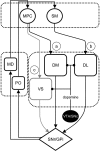The role of the dorsal striatum in reward and decision-making - PubMed (original) (raw)
Review
The role of the dorsal striatum in reward and decision-making
Bernard W Balleine et al. J Neurosci. 2007.
Abstract
Although the involvement in the striatum in the refinement and control of motor movement has long been recognized, recent description of discrete frontal corticobasal ganglia networks in a range of species has focused attention on the role particularly of the dorsal striatum in executive functions. Current evidence suggests that the dorsal striatum contributes directly to decision-making, especially to action selection and initiation, through the integration of sensorimotor, cognitive, and motivational/emotional information within specific corticostriatal circuits involving discrete regions of striatum. We review key evidence from recent studies in rodent, nonhuman primate, and human subjects.
Figures
Figure 1.
Corticostriatal circuits involved in decision-making. a, b, The learning processes controlling the acquisition of reward-related actions are mediated by converging projections from regions of anteromedial prefrontal cortex (MPC) to the rodent dorsomedial striatum or primate dorsoanterior striatum (DM), whereas the processes mediating the acquisition of stimulus-bound actions, or habits, are thought to be mediated by projections from sensorimotor cortex (SM) to the rodent dorsolateral–primate dorsoposterior striatum (DL) (b). These corticostriatal connections are parts of distinct feedback loops that project back to their cortical origins via substantia nigra pars reticulata (SNr)/globus pallidus internal segment (GPi) and the mediodorsal (MD)/posterior (PO) nuclei of the thalamus. c, Reward and predictors of reward are the major motivational influences on the performance of goal-directed and habitual actions that are thought to be mediated by corticostriatal circuits involving, particularly, ventral striatum (VS) and regions of the amygdala. Dopamine is an important modulator of plasticity in the dorsal striatum, whereas its tonic release has long been associated with the motivational processes mediated by the ventral circuit. VTA, Ventral tegmental area; SNc, substantia nigra pars compacta.
Similar articles
- Corticostriatal circuitry.
Haber SN. Haber SN. Dialogues Clin Neurosci. 2016 Mar;18(1):7-21. doi: 10.31887/DCNS.2016.18.1/shaber. Dialogues Clin Neurosci. 2016. PMID: 27069376 Free PMC article. Review. - Between the primate and 'reptilian' brain: Rodent models demonstrate the role of corticostriatal circuits in decision making.
Lee AM, Tai LH, Zador A, Wilbrecht L. Lee AM, et al. Neuroscience. 2015 Jun 18;296:66-74. doi: 10.1016/j.neuroscience.2014.12.042. Epub 2015 Jan 7. Neuroscience. 2015. PMID: 25575943 Free PMC article. Review. - The involvement of the striatum in decision making.
Goulet-Kennedy J, Labbe S, Fecteau S. Goulet-Kennedy J, et al. Dialogues Clin Neurosci. 2016 Mar;18(1):55-63. doi: 10.31887/DCNS.2016.18.1/sfecteau. Dialogues Clin Neurosci. 2016. PMID: 27069380 Free PMC article. Review. - Reward-related cortical inputs define a large striatal region in primates that interface with associative cortical connections, providing a substrate for incentive-based learning.
Haber SN, Kim KS, Mailly P, Calzavara R. Haber SN, et al. J Neurosci. 2006 Aug 9;26(32):8368-76. doi: 10.1523/JNEUROSCI.0271-06.2006. J Neurosci. 2006. PMID: 16899732 Free PMC article. - Dissociable contributions of dorsal and ventral striatal regions on a rodent cost/benefit decision-making task requiring cognitive effort.
Silveira MM, Tremblay M, Winstanley CA. Silveira MM, et al. Neuropharmacology. 2018 Jul 15;137:322-331. doi: 10.1016/j.neuropharm.2018.04.025. Epub 2018 Apr 24. Neuropharmacology. 2018. PMID: 29778947
Cited by
- Lower dorsal striatum activation in association with neuroticism during the acceptance of unfair offers.
Servaas MN, Aleman A, Marsman JB, Renken RJ, Riese H, Ormel J. Servaas MN, et al. Cogn Affect Behav Neurosci. 2015 Sep;15(3):537-52. doi: 10.3758/s13415-015-0342-y. Cogn Affect Behav Neurosci. 2015. PMID: 25720857 Free PMC article. - Medial prefrontal cortex inversely regulates toluene-induced changes in markers of synaptic plasticity of mesolimbic dopamine neurons.
Beckley JT, Evins CE, Fedarovich H, Gilstrap MJ, Woodward JJ. Beckley JT, et al. J Neurosci. 2013 Jan 9;33(2):804-13. doi: 10.1523/JNEUROSCI.3729-12.2013. J Neurosci. 2013. PMID: 23303956 Free PMC article. - The Interplay between Emotion and Cognition in Autism Spectrum Disorder: Implications for Developmental Theory.
Gaigg SB. Gaigg SB. Front Integr Neurosci. 2012 Dec 4;6:113. doi: 10.3389/fnint.2012.00113. eCollection 2012. Front Integr Neurosci. 2012. PMID: 23316143 Free PMC article. - Research Review: altered reward function in adolescent depression: what, when and how?
Forbes EE, Dahl RE. Forbes EE, et al. J Child Psychol Psychiatry. 2012 Jan;53(1):3-15. doi: 10.1111/j.1469-7610.2011.02477.x. Epub 2011 Nov 28. J Child Psychol Psychiatry. 2012. PMID: 22117893 Free PMC article. Review. - Gray Matter Changes in Adolescents Participating in a Meditation Training.
Yuan JP, Connolly CG, Henje E, Sugrue LP, Yang TT, Xu D, Tymofiyeva O. Yuan JP, et al. Front Hum Neurosci. 2020 Aug 14;14:319. doi: 10.3389/fnhum.2020.00319. eCollection 2020. Front Hum Neurosci. 2020. PMID: 32922278 Free PMC article.
References
- Alexander GE, Crutcher MD. Functional architecture of basal ganglia circuits: neural substrates of parallel processing. Trends Neurosci. 1990;13:266–271. - PubMed
- Antonini A, Moresco RM, Gobbo C, De Notaris R, Panzacchi A, Barone P, Calzetti S, Negrotti A, Pezzoli G, Fazio F. The status of dopamine nerve terminals in Parkinson's disease and essential tremor: a PET study with the tracer [11-C]FE-CIT. Neurol Sci. 2001;22:47–48. - PubMed
- Balleine BW. Neural bases of food seeking: affect, arousal and reward in corticostriatolimbic circuits. Physiol Behav. 2005;86:717–730. - PubMed
- Balleine BW, Dickinson A. Goal-directed instrumental action: contingency and incentive learning and their cortical substrates. Neuropharmacology. 1998;37:407–419. - PubMed
Publication types
MeSH terms
LinkOut - more resources
Full Text Sources
Other Literature Sources
